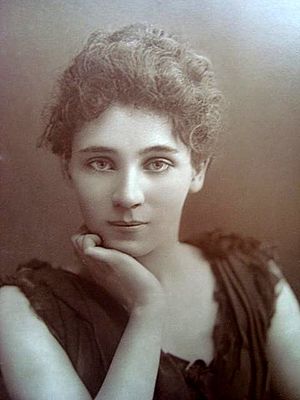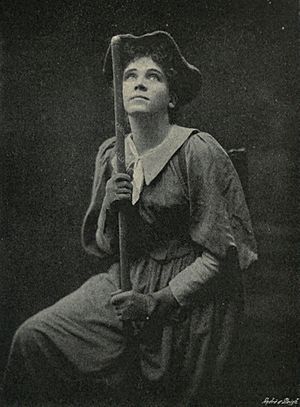Elizabeth Robins facts for kids
Quick facts for kids
Elizabeth Robins
|
|
|---|---|
 |
|
| Born | August 6, 1862 |
| Died | May 8, 1952 (aged 89) |
| Other names | C.E. Raimond |
| Spouse(s) | George Richmond Parks (1885–1887) |
Elizabeth Robins (born August 6, 1862 – died May 8, 1952) was a talented woman who was an actress, a playwright (someone who writes plays), a novelist (someone who writes novels), and a suffragette (someone who fought for women's right to vote). She also wrote books using the pen name C. E. Raimond.
Contents
Early Life and Dreams
Elizabeth Robins was born in Louisville, Kentucky. When she was young, her family faced money problems. Her father moved to Colorado, and her mother became unwell. Elizabeth and her siblings went to live with their grandmother in Zanesville, Ohio. Her grandmother was very supportive and gave her a copy of The Complete Works of William Shakespeare. This helped Elizabeth dream of becoming an actress in New York City.
Elizabeth's father had modern ideas and wanted her to study medicine at Vassar College. However, when she was 14, she saw her first professional play, Hamlet. This experience made her want to act even more. From 1880 to 1888, she worked as an actress in America.
Becoming a Star Actress
After moving to New York, Elizabeth Robins quickly joined Edwin Booth's theatre company. By 1882, she was touring with plays. She soon wanted more challenging roles and joined the Boston Museum stock company in 1883. There, she met George Parks, who she married in 1885. Elizabeth became very popular and was often on tour. Sadly, George Parks passed away in 1887.
On September 3, 1888, Elizabeth moved to London, England. She stayed there for the rest of her life, only visiting the U.S. to see her family.
Soon after arriving in London, she met the famous writer Oscar Wilde. He often watched her perform and gave her advice. After seeing her in a play called The Real Little Lord Fauntleroy in 1889, Wilde told her she was "an actress of the first order" and that her future on the stage was "assured."
Elizabeth became very interested in the plays of Henrik Ibsen, a Norwegian writer. In 1891, she worked with another actress, Marion Lea. They formed their own theatre company. This was a big step for Elizabeth, as she wanted to create a theatre with high artistic standards. They focused on "women's plays" written by men like Ibsen, bringing strong female characters to the stage. George Bernard Shaw, another famous writer, noticed that "the Woman Question" (meaning women's rights) was becoming important in theatre.
Elizabeth Robins and Marion Lea were the first to bring Ibsen's play Hedda Gabler to the English stage. This role became very important for Elizabeth. Critics said she was amazing in it. From then on, many people thought of Elizabeth Robins when they heard the name Hedda. She and Lea continued to produce Ibsen's 'New Woman' plays, which featured independent and strong female characters. Acting in and producing these plays helped Elizabeth become a strong supporter of women's rights. She became known in Britain as "Ibsen's High Priestess" because of her dedication to his work.
Elizabeth Robins ended her acting career at age 40. She had become famous not just as an actress, but also as an actress-manager, someone who both acts and helps run the theatre.
A Career in Writing
Elizabeth Robins realized that acting income wasn't always steady. She also had to leave England to search for her brother, who had gone missing in Alaska. Her adventures looking for him inspired her to write novels like Magnetic North (1904) and Come and Find Me (1908).
Before this, she had already written other novels such as George Mandeville's Husband (1894) and The New Moon (1895). She used the name C. E. Raimond for these early books to keep her acting and writing careers separate. However, when the media found out she was C. E. Raimond, she started publishing under her own name. She also secretly co-wrote a play called Alan's Wife with Florence Bell. Elizabeth had a long and successful career writing both fiction and non-fiction.
Her novel The Convert (1907) showed her strong ideas about women's rights. The main character, Vida, speaks to male politicians, which was very unusual for women at that time. This novel was based on Elizabeth's most successful play, Votes for Women! This play was the first to show the street protests of the women's suffrage movement on stage. It led to many other plays about women's right to vote. Elizabeth became very dedicated to the cause of women's suffrage as she worked on this play.
Fighting for Women's Rights
Elizabeth Robins joined groups like the National Union of Women's Suffrage Societies and the Women's Social and Political Union. However, she disagreed with some of the more forceful methods used by the Women's Social and Political Union. Even so, she remained a strong supporter of women's rights. She used her skills as a speaker and writer to help the cause.
Her book The Convert became very important to the suffrage movement. Elizabeth continued to be an active feminist throughout her life. In the 1920s, she wrote regularly for Time and Tide, a feminist magazine. She also wrote books like Ancilla's Share: An Indictment of Sex Antagonism, which explored problems of gender inequality.
Frederick Pethick-Lawrence, 1st Baron Pethick-Lawrence, a politician, said that Robins helped him understand the difference between a suffragette (who might use more direct action) and a suffragist (who worked through peaceful means).
Robins also supported the campaign to allow women to join the House of Lords, which is part of the British Parliament. Her friend, Margaret Haig, was supposed to inherit her father's title, Viscountess Rhondda. This was unusual because women didn't normally inherit such titles. When her father died in 1918, the House of Lords refused to let Margaret take her seat. Elizabeth Robins wrote many articles about this issue, but the House of Lords didn't change its mind until 1958, long after Elizabeth's efforts.
Personal Life and Friendships
Elizabeth Robins was a very independent woman. She had a brief marriage to George Parks, but after his death, she remained single. She was very intelligent and became friends with many important writers and artists in London, including George Bernard Shaw, Oscar Wilde, and Henry James.
In 1900, she traveled alone to the gold rush camps in Alaska to find her brother Raymond Robins, who she worried was lost. After a difficult journey, she found him in Nome. She stayed with him in Alaska for the summer. Her time there was tough, and she caught typhoid fever, which affected her health for the rest of her life. Her adventures in Alaska gave her ideas for many articles and her best-selling book, The Magnetic North.
Even though she didn't become a doctor as her father wished, Elizabeth remained very interested in medicine. In 1909, she met Octavia Wilberforce, a young woman who desperately wanted to study medicine but whose family didn't support her. Elizabeth and other friends helped Octavia financially and morally until she became a doctor. Elizabeth and Octavia had a very close relationship, much like a mother and daughter. In her later years, Elizabeth also became friends with Virginia and Leonard Woolf, famous writers. Dr. Wilberforce cared for Elizabeth until she passed away in 1952, just before her 90th birthday.
Works
Anonymously, with Florence Bell, she wrote:
- Alan's Wife, 1893
As C. E. Raimond, she wrote:
- George Mandeville's Husband, 1894
- The New Moon, 1895
- Below the Salt, 1896
- The Open Question, 1898
The success of this last novel led to her publishing under her own name:
- The Alaska-Klondike Diary of Elizabeth Robins, 1900
- The Magnetic North, 1904
- A Dark Lantern, 1905 (filmed in 1920)
- The Convert, 1907
- Votes for Women! (A suffrage play produced at the Royal Court Theatre, Sloane Square, London), 1907
- Come and Find Me, 1908, a sequel to The Magnetic North
- My Little Sister, 1913 (filmed in 1919)
- Camilla, 1918
- The Messenger, 1920
- Ancilla's Share : an indictment of sex antagonism, 1924
- The Florentine Frame, 1909
Images for kids
See also
 In Spanish: Elizabeth Robins para niños
In Spanish: Elizabeth Robins para niños




